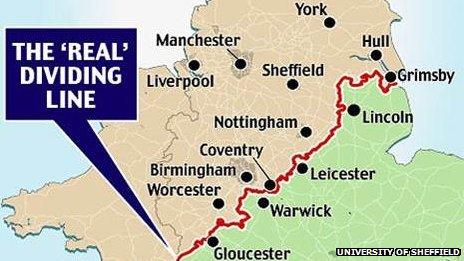Why Coventry has a crucial say in devolution debate
- Published
- comments

Q. "What do you get if you draw a line from Gloucester north east to Grimsby?"
A. "The real dividing line between north and south," says Professor David Bailey, from Aston University in Birmingham.
But his is a controversial view, as I discovered during The Big Business Debate, organised by the Coventry and Warwickshire Chamber of Commerce.
It brought together more than 100 business, political and academic leaders from across the West Midlands in an early morning discussion at the Ricoh Arena.
Prof Bailey's line, based on research by the University of Sheffield, places Coventry on the opposite side from important parts of its hinterland, including the county town of Warwick itself.
Among the dissenting voices at the debate was Jerry Blackett, chief executive of the Greater Birmingham and Solihull Chambers.
He was convinced that whatever side of the line it falls, the West Midlands stands together and must not allow itself to be rent asunder by any arbitrary axes.
You will have gathered from my recent posts that these questions have been sharpened by the increasing energy behind the the English devolution agenda.

'Historic agreement'
Among the panellists was the Conservative MP for Rugby Mark Pawsey.
He told the meeting that this decentralisation of politics was seen by all three main Parliamentary parties, with only subtle variations between them, as an answer not just to the Scottish Question but also as a way of empowering non-metropolitan England to emerge from its total eclipse by planet London.
It is just over a month since the Labour Leader of Sandwell Council, Darren Cooper went public with what he called the "historic agreement" that he had patiently negotiated behind the scenes.
The four Black Country councils and their great long-time rival, Birmingham, had agreed to work together towards a combined authority in the hope that they could emulate that much-vaunted "northern economic powerhouse" in winning billions of pounds worth of devolved spending power from central government.
I mentioned last time that Coventry and Solihull are currently considering whether or not to join the Birmingham and Black Country venture, or to go in with Warwickshire in another combined authority altogether, of which there are in turn a variety of possible permutations.
It was lost on none of those present that Coventry is on the cusp of a great political decision.
As the Labour Leader of Coventry City Council, Ann Lucas, told last week's Sunday Politics show, she and her fellow councillors have to determine whether the city's centre of gravity inclines it towards Warwickshire, the Cotswolds and their neighbouring shires, or towards the West Midlands conurbation.
'Crown Jewels'
Coventry's decision, expected early in the New Year, will have a huge bearing not just on the city itself but on those around it.
If Coventry forms a partnership with Birmingham and the Black Country could cautious Solihull, sandwiched in the middle, realistically stand aside from it?
Solihull is after all the home of Birmingham Airport, the National Exhibition Centre and the proposed HS2 high speed rail interchange station.
How could a combined authority of whatever composition, operate credibly without the borough generally seen to possess the region's Crown Jewels? Who most needs whom?
Several themes emerged loud and clear from the debate - from business leaders, the need for quick, clear-cut decision-making and effective delivery mechanisms. The politicians meanwhile called for those decisions to be well-made and pay due regard to local priorities.
And on the fundamental question, the mood of the meeting was clear. On a show of hands, a tie-up with the Black Country and Birmingham won about three times as much support as the Coventry and Warwickshire alternative.
This was in no sense a scientific sample of course. But as a representation of opinion among key local decision-makers, it could prove just as influential a marker as that red line on Professor Bailey's map.
- Published3 December 2014
- Published12 November 2014
- Published7 November 2014
- Published6 November 2014
